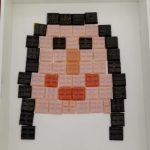
Click here for the gallery of the 74 mosaics made by visitors to the CLASP stand at the Milton Keynes Festival of History in June 2019.

Click here for the gallery of the 74 mosaics made by visitors to the CLASP stand at the Milton Keynes Festival of History in June 2019.
CLASP has been involved in a joint project with MOLA researching the hill-fort on Borough Hill, Daventry, which is assessed as being the second largest hill-fort in the country.
CLASP has now agreed with MOLA that for the Council of British Archaeology (CBA) National Archaeology Week 2019, we will jointly provide a series of guided walks over at least part of the site, starting at the Daventry Golf Club at the northern end.
These walks will take place on the afternoons of Thursday 25th and Sunday 28th July. We now need volunteers from the CLASP membership to assist with the events to act as both guides and generally assisting on the day. You will be fully briefed as to latest details about the hill-fort etc., hopefully with a walk round to brief volunteers before the event begins.
If you can volunteer to assist please email me on:-
chair_trustees@claspweb.org.uk
Thanks in advance!
Dave Hayward
CLASP ran its two 2-day Archaeology Taster courses on 4th to 7th July 2019. Twenty-three attended plus five CLASP presenters supported by five other Members.
The first day of each course was mainly in the CLASP Field Centre covering Best Practices , Field-walking, Planning, Context, Geophysics and Surveying. On the second day participants chose between practical training on Geophysics or Surveying.
Feedback on the days was very positive. CLASP gained many new Members. Participants had very diverse skills and can utilise these to be active in CLASP in many diverse ways.
See the CLASPWEB Facebook group for some photos and feedback.
Subject to sufficient interest, CLASP will run a two-day Archaeology Taster/Refresher Session on Thursday 4th and Friday 5th July
to be repeated on
Saturday 6th July and Saturday 7th July.
British Museum, 31 May 2019
A report by CLASP Member Hilary Calow
The event was held as part of the Grave Goods Project www.gravegoodsproject.org
This website has just been upgraded to new a server so we could add an SSL Certificate. That means we are now operating at the industry-standard levels of security. That annoying “Not secure” has vanished from the URL search bar, and people submitting their Membership Application form will no longer be warned that they should not do so because “the site is not secure”.
Onwards and upwards.
We’re still assessing interest in a “100 Club” to help find CLASP. Make a modest payment monthly and stand to win in the monthly draw!
Have a read of the details below and email Rob Close if you are interested (there’s an email link on the details page).
Details here:
Excavation Open Day on Saturday 18th May 10am-3pm at Mill Common, Huntingdon
Mill Common, Huntindon (opposite Huntingdon bus station)
* Please note there is no parking available on site.
As part of Highways England’
scheme, there is an open day for members of the public to see an ongoing
archaeological excavation taking place at Mill Common in Huntingdon.
There will be free guided tours every 30 minutes from 10am-12pm and from
1pm-2:30pm. This is a chance to see finds from the excavation, meet some
of the archaeologists and find out more about the excavations along the
A14. For more information, please see the attached poster.